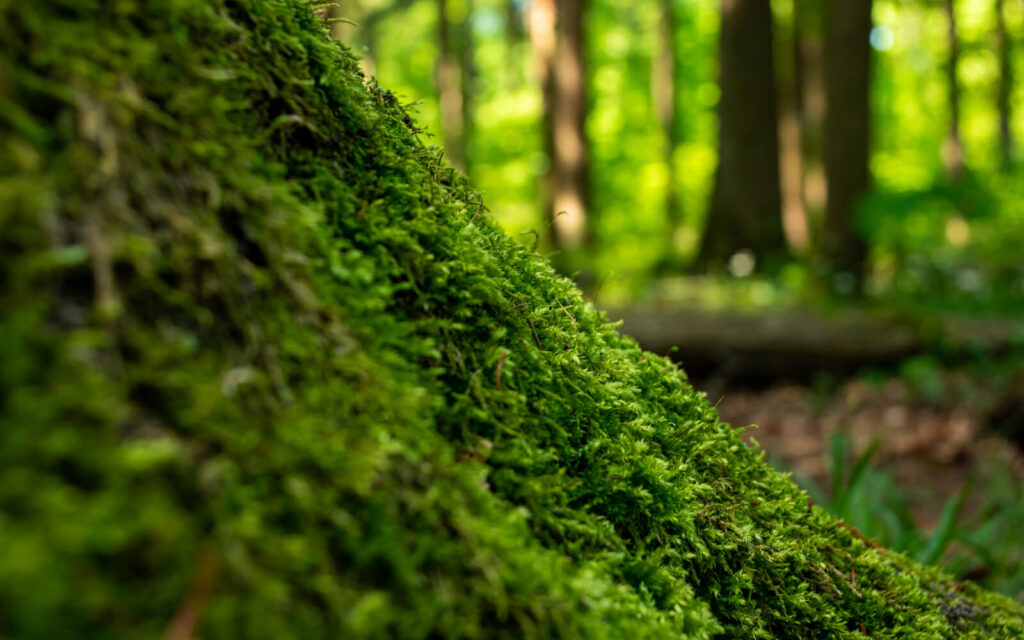Moss and Lichens: Winter’s Quiet Survivors
October 28, 2025
By Laura Fawks Lapole
Naturalist

The winter landscape is often subdued, painted in shades of brown, gray and white. Most plants lie dormant and even the birds wear their muted winter plumage. Yet, if you look closely at the ground beneath your feet or on the trunks of trees and the surfaces of rocks, you may spot a surprising splash of green, yellow or orange. These bursts of color come from mosses and lichens, extraordinary organisms that not only survive but often thrive in the coldest months of the year.
Mosses are non-vascular plants, meaning they lack the vascular tissues needed to transport water and nutrients throughout the plant. Because of this, they remain small and thrive in moist environments where water is readily available. Like other plants, mosses have leaf-like structures and contain chloroplasts that allow them to photosynthesize.
Lichens are plant-like in appearance but are not actually plants. They are symbiotic organisms composed of a fungus and an alga (either green or blue) living together in a mutually beneficial relationship. The fungus provides the structure and protection, while the alga photosynthesizes to produce food. This partnership benefits both organisms. The fungus gains nutrients from the alga’s photosynthesis and the alga has a safe, stable environment in which to grow and reproduce. Like mosses, lichens require moist conditions to thrive, which is why they are often found growing alongside mosses.
What allows lichens and mosses to survive in harsh conditions when most other plants go dormant? These organisms possess remarkable adaptations that enable them to tolerate cold temperatures, low light and dry environments, as well as to transition rapidly between dormancy and active growth. To understand this resilience, let’s first explore how they endure cold temperatures.
When it comes to freezing temperatures, lichens are generally hardier than mosses. They have been observed growing in environments as cold as minus 1.4 degrees. This resilience is due in part to their ability to produce chemical compounds that function much like the antifreeze used in cars, preventing ice from forming within their tissues. By avoiding internal freezing, lichens remain undamaged and can resume growth whenever conditions improve. In addition, some lichens exude specialized proteins that encourage the formation of an external layer of ice crystals, creating a protective barrier without harming the organism itself.
Mosses, while also tolerant of cold, are somewhat more sensitive. They can survive near-freezing conditions but typically cannot thrive far below that threshold. However, they are capable of changing their metabolism to continue growing in temperatures as low as 19.4 degrees. Amazingly, their dense growth patterns, dark pigmentation and overlapping leaf structures can create a microclimate that traps heat, which allows temperatures around the moss surface to reach up to 86°F in full sunlight, even when the surrounding air is zero degrees.
Another major challenge in winter is the lack of available water. The air is often extremely dry and, when water is present, it is frequently locked away as ice. As previously mentioned, both lichens and mosses require moisture to grow and carry out photosynthesis. Some lichen species have evolved strategies to cope with this limitation. They can absorb water directly from the air when humidity is high and some are even able to utilize moisture from melting or evaporating snow. Mosses exhibit similar adaptations, relying on snowmelt as an essential source of water during cold months.
Day length is shorter in winter and, for mosses and lichens that grow close to the ground, snow cover can further limit available sunlight. Both factors create low-light conditions that are far from ideal for photosynthesis. Fortunately, these organisms have evolved adaptations to cope with this challenge. Moss leaves are designed with a large surface area to capture as much sunlight as possible. They can even make use of the small amount of light that filters through shallow layers of snow. Lichens also display flexibility. Some species thrive in intense sunlight, while others are adapted to shaded environments. Those that prefer shade are well suited to the dim light of winter, allowing them to continue photosynthesis even under snow-covered conditions.
But what happens when these harsh conditions become too extreme, even for these resilient organisms? Mosses and lichens are both remarkably adapted to handle desiccation (drying out) by entering a dormant state. Instead of struggling to survive and risking death, they simply shut down. They stop photosynthesizing, release any remaining moisture and wait patiently for better conditions. Some moss species can endure up to nine months without water and then quickly revive once moisture returns. In one incredible example, scientists revived Antarctic moss that had been frozen in an ice core for about 1,500 years. Once warmed and watered, it began to grow again.
Lichens display equally astonishing resilience. When dormant, they can survive for at least a decade — and even withstand the vacuum, radiation and temperature extremes of outer space. Unlike larger plants that require time to restart their biological processes, both mosses and lichens can shift almost instantly between dormancy and activity, allowing them to take full advantage of every favorable moment.
Though often overlooked, mosses and lichens play vital roles in their ecosystems. They thrive in environments where few other organisms can survive, provide food and shelter for a variety of wildlife, and help stabilize soil to prevent erosion. If you take a closer look this winter — at tree trunks, rocks or even the ground beneath your feet — you may find a surprising splash of green or orange. These small but mighty organisms are a living reminder that even in the harshest conditions, life finds a way.